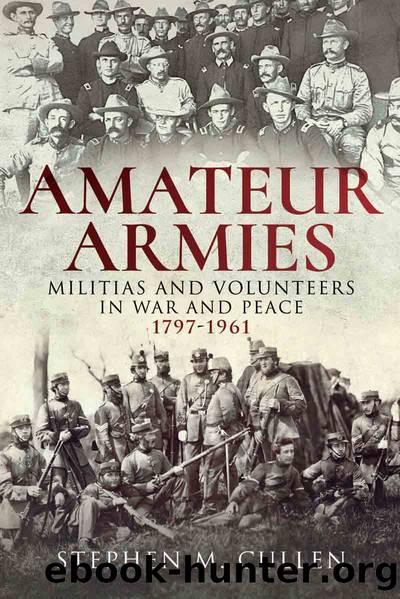Amateur Armies by Stephen M Cullen;

Author:Stephen M Cullen;
Language: eng
Format: epub
Tags: History / Military / General
Publisher: Casemate Publishers & Book Distributors, LLC
Published: 2020-02-15T00:00:00+00:00
It was the Volunteers, in particular, that were seen to represent the nation in arms. Interestingly, the rush to war on the part of these men was used by both the US government and American commentators as evidence of the unity of the nation. Racial divisions, and the still-potent post-Civil War divisions were, it was claimed, being overcome by a shared American enterprise to bring freedom to Cuba. Teddy Roosevelt made much of this in his rapidly published memoir of the war and the role that he and his Volunteers in the First US Volunteer Cavalry played in the US victory. His Volunteers came mostly from the âFour Territoriesâ â New Mexico, Arizona, Oklahoma, and Indian Territory â and included native Americans. Roosevelt made much of the wide range of American âtypesâ, from Ivy League sportsmen to cowboys and âlawless spiritsâ that joined his âRough Ridersâ, and among these there were, âa number of Indians â Cherokees, Chickasaws, Choctaws, and Creeks. Only a few were of pure blood. The others shaded off until they were absolutely indistinguishable from their white comrades; with whom, it may be mentioned, they all lived on terms of complete equalityâ.17 Some 3,000 Black Americans were also part of the expeditionary force, but in the Regular Army in segregated âcoloredâ regiments: 9 and 10 Cavalry, and the 24 and 25 Infantry. Rooseveltâs Rough Riders, as a cavalry regiment (albeit without their mounts on Cuba) were brigaded with the Black Regulars, and both took part in the famous assault on San Juan Hill. Paying tribute to them, he said, âBetween you [the Black Regulars] and the other cavalry regiments there is a tie which we trust will never be brokenâ.18
The Volunteer enthusiasm for the war was also used by many as a way of attempting to bury the lingering but strong resentment that existed in the South against the US government and army. The federal government in Washington was keenly aware of the potential for a violent reaction that shipping tens of thousands of soldiers in blue through Southern states to Florida might have. Volunteer Post recorded how the 71st New York Volunteers, entrained for Florida, were routed away from the old Confederate capital of Richmond:
It seemed that there were two ways to get to Florida by rail. One of them would take us through Richmond, Virginia; the other would go around it.
Which route? We were a Northern regiment. We were âBoys in Blueâ! It was only 1898 remember, and the question was profound. Would we be fired upon or would we not?19
Download
This site does not store any files on its server. We only index and link to content provided by other sites. Please contact the content providers to delete copyright contents if any and email us, we'll remove relevant links or contents immediately.
The Radium Girls by Kate Moore(11621)
100 Deadly Skills by Clint Emerson(4689)
The Templars by Dan Jones(4557)
Rise and Kill First by Ronen Bergman(4545)
The Doomsday Machine by Daniel Ellsberg(4245)
The Rape of Nanking by Iris Chang(4022)
Killing England by Bill O'Reilly(3896)
Hitler in Los Angeles by Steven J. Ross(3798)
Stalin by Stephen Kotkin(3724)
12 Strong by Doug Stanton(3419)
Hitler's Monsters by Eric Kurlander(3163)
Blood and Sand by Alex Von Tunzelmann(3055)
Darkest Hour by Anthony McCarten(3018)
The Code Book by Simon Singh(2856)
The Art of War Visualized by Jessica Hagy(2837)
Hitler's Flying Saucers: A Guide to German Flying Discs of the Second World War by Stevens Henry(2624)
Babylon's Ark by Lawrence Anthony(2427)
The Second World Wars by Victor Davis Hanson(2421)
Tobruk by Peter Fitzsimons(2374)
